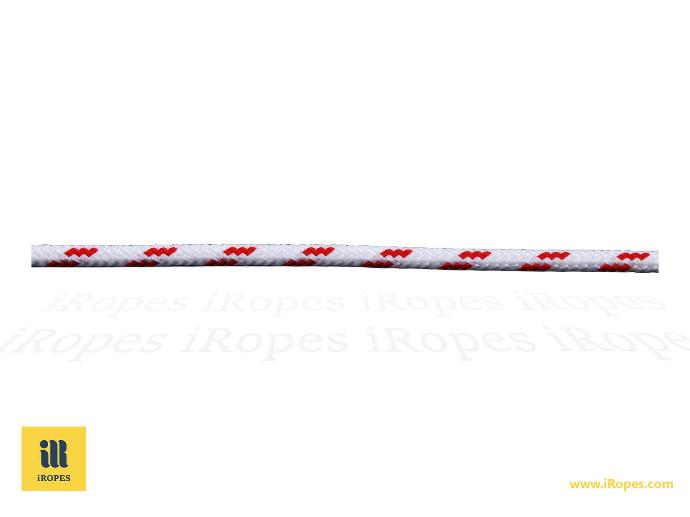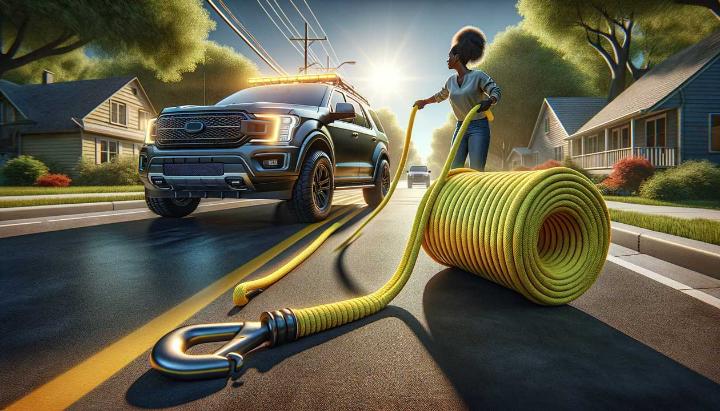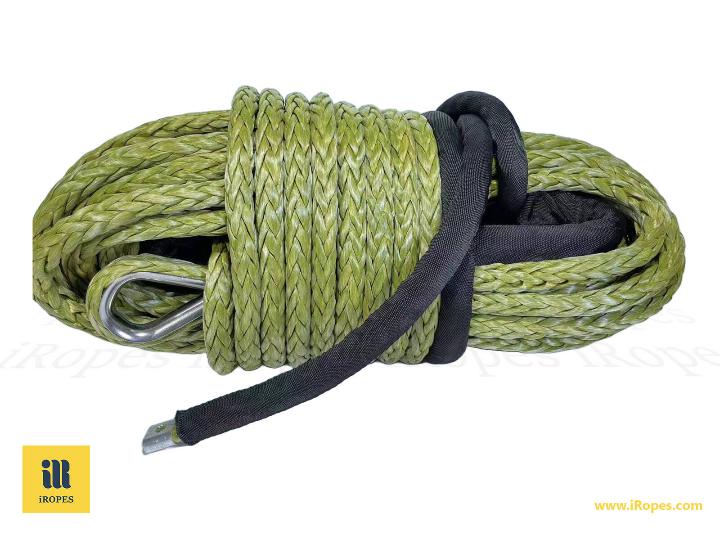Have you ever found yourself in a tight spot, desperately needing a reliable rope but unsure which type to choose? Whether you're an outdoor enthusiast, a professional in the construction industry, or simply someone who values preparedness, understanding the nuances of rope grip and wire rope grip is crucial. In this ultimate guide, we'll unravel the mysteries of wire rope grip, rope grip, and grip tow rope essentials, with a special focus on the game-changing advantages of fibre ropes.
Imagine effortlessly handling a rope that's both incredibly strong and surprisingly lightweight. That's the magic of fibre ropes. Their flexibility and ease of use have revolutionised industries across the board, from maritime operations to extreme sports. But why should you care about the type of rope you're using?
The truth is, choosing the right rope can mean the difference between a successful operation and a dangerous failure. This guide will equip you with the knowledge to make informed decisions, enhance your safety, and boost your efficiency in any rope-related task. Whether you're securing cargo, planning a rescue operation, or preparing for your next off-road adventure, you'll discover why mastering rope grip techniques and understanding wire rope grip essentials are skills that pay dividends.
Join us as we explore the world of ropes, from the latest innovations in fibre technology to time-tested wire rope applications. Get ready to elevate your rope game and tackle any challenge with confidence. Let's dive in and uncover the secrets that will make you a rope handling pro!
Advantages of Fiber Ropes: Flexibility and Ease of Use
When it comes to choosing the right rope for your needs, fiber ropes offer a compelling set of advantages that make them stand out from their wire counterparts. As someone who's spent years working with various types of ropes, I can attest to the remarkable benefits that fiber ropes bring to the table.
Superior Flexibility for Diverse Applications
One of the most striking features of fiber ropes is their incredible flexibility. Unlike wire ropes, which can be stiff and unyielding, fiber ropes bend and flex with ease. This flexibility translates into a wide range of benefits:
- Improved handling and maneuverability: Fiber ropes are much easier to coil, uncoil, and manipulate, making them ideal for tasks that require quick adjustments.
- Enhanced performance in dynamic applications: The flexibility allows fiber ropes to absorb shock and resist fatigue, making them perfect for marine environments or applications with frequent load changes.
- Versatility across industries: From construction and shipping to outdoor recreation, fiber ropes adapt to various scenarios with ease.
Lightweight Design Enhances Usability
Another game-changing advantage of fiber ropes is their lightweight nature. Having lugged both wire and fiber ropes around job sites, I can personally vouch for the difference this makes:
- Reduced physical strain: Fiber ropes are significantly lighter than wire ropes of the same diameter, making them easier to transport and handle, especially over long periods.
- Increased efficiency: The lightweight design allows for quicker setup and breakdown times, boosting overall productivity.
- Enhanced safety: Lighter ropes reduce the risk of strain injuries and accidents during handling, a crucial factor in many industrial settings.
Did You Know?
High-performance synthetic fiber ropes can have up to 75% less weight than steel wire ropes of equivalent strength!
The combination of flexibility and lightweight design makes fiber ropes an excellent choice for a wide range of applications. Whether you're securing cargo, rigging a sailboat, or setting up a safety line, fiber ropes offer the perfect blend of performance, ease of use, and versatility.
A line in modern, fresh colors and many diameters, easy to splice, and
suited for various uses aboard any yacht.
MATERIAL: polyester-polyester
CONSTRUCT: 8/16x2
ELONGATION: 15%
Have you ever experienced the difference between handling a fiber rope and a wire rope? The contrast is truly remarkable, and it's one of those things you have to feel to fully appreciate. Next time you're choosing a rope for your project, consider giving fiber ropes a try - your hands (and back) will thank you!
Rope Grip Techniques: Mastering the Fundamentals
As an experienced climber and rope enthusiast, I can't stress enough how crucial proper rope grip techniques are for both safety and efficiency. Whether you're scaling a rock face or securing a heavy load, mastering these fundamentals can make all the difference.
Perfecting Your Foot Grip for Efficient Climbing
Let's start from the ground up - quite literally! A solid foot grip is the unsung hero of rope climbing. I remember when I first learned the foot clamp technique; it was a game-changer.
- The foot clamp technique: Step on the rope with one foot, then wrap it over the top and under your other foot. This creates a secure 'clamp' that takes the weight off your arms.
- Reduced hand fatigue: By using your legs to support your weight, you'll conserve energy in your arms and grip strength for when you really need it.
- Practice makes perfect: Start low to the ground and practice the foot clamp until it becomes second nature. Your future self will thank you!
Hand Grip Strategies for Strength and Endurance
Now, let's talk about what's happening up top. Your hand grip is your lifeline on the rope, and there are a few key methods to master:
- The V-method: Form a 'V' with your thumb and forefinger around the rope, with your palm facing down. This grip offers a good balance of control and endurance.
- The wrap method: For extra security, wrap the rope once around your wrist before gripping. Just be cautious not to restrict blood flow.
- Grip strength exercises: Off the rope, try dead hangs, farmer's walks, and plate pinches to build grip strength. Your climbing will thank you!

Pro Tip
Alternate your grip regularly during long climbs to prevent fatigue and reduce the risk of repetitive strain injuries.
Remember, technique trumps raw strength every time. I've seen beginners outclimb muscular gym-goers simply because they've mastered these fundamental rope grip techniques. So, take the time to practice, and you'll be amazed at how quickly your climbing improves.
Have you tried these techniques before? What's your go-to method for maintaining a strong grip during a tough climb? Share your experiences in the comments below - I'd love to hear about your rope adventures!
Wire Rope Grip: Ensuring Safe and Efficient Operations
As someone who's worked extensively with wire ropes in various industrial settings, I can't stress enough the importance of proper wire rope grip usage. These seemingly simple devices play a crucial role in ensuring safety and efficiency across a wide range of applications, from construction sites to maritime operations.
Safety Precautions for Wire Rope Usage
When it comes to wire rope grips, safety should always be your top priority. Here are some essential precautions to keep in mind:
- Proper selection: Choose the right size and type of wire rope grip for your specific application. Using the wrong grip can lead to dangerous slippage or failure.
- Correct installation: Always follow the manufacturer's instructions for installation. Improper placement or tightening can significantly reduce the grip's effectiveness.
- Regular inspections: Implement a routine inspection schedule to check for signs of wear, corrosion, or damage. Early detection of issues can prevent catastrophic failures.
- Load limits: Never exceed the recommended load capacity of the wire rope or grip. Always factor in the safety margin when calculating loads.
OSHA Guidelines for Wire Rope Operations
The Occupational Safety and Health Administration (OSHA) provides comprehensive guidelines for wire rope operations. As a safety-conscious professional, I've always found these regulations invaluable:
- Training requirements: Ensure all personnel working with wire ropes are properly trained in safe handling and operation procedures.
- Inspection criteria: OSHA outlines specific criteria for wire rope inspections, including when to remove ropes from service due to visible defects or excessive wear.
- Documentation: Maintain detailed records of wire rope inspections, maintenance, and replacements to ensure compliance and traceability.
Remember, the safety factor for wire ropes is typically 5:1 for general use, but increases to 20:1 for personnel lifting operations. Always err on the side of caution when it comes to safety!
By adhering to these safety precautions and OSHA guidelines, you'll significantly reduce the risk of accidents and ensure smooth, efficient operations. Have you encountered any challenges with wire rope grips in your work? I'd love to hear about your experiences and any additional safety tips you might have!
In the next section, we'll dive deeper into understanding wire rope safety factors and how they impact your operations. Learn more in our article on wire rope safety and key benefits, which could potentially save lives and improve your workflow!
grip tow rope: Essential Tips for Effective Towing
As someone who's spent years off-roading and helping fellow adventurers out of sticky situations, I can't stress enough the importance of mastering the art of towing. Whether you're a weekend warrior or a seasoned pro, understanding the ins and outs of grip tow ropes can make all the difference when you're faced with a vehicle recovery situation.
Choosing the Right Tow Rope for Your Vehicle
When it comes to selecting the perfect grip tow rope, there's no one-size-fits-all solution. The key is matching the rope to your specific needs and vehicle specifications. Here's what you need to consider:
- Tow rope vs. recovery strap: While they may look similar, these serve different purposes. Tow ropes are designed for pulling a rolling vehicle, while recovery straps are built to withstand the shock of extracting a stuck vehicle.
- Material matters: Nylon ropes offer excellent stretch and shock absorption, making them ideal for most towing situations. However, for heavier loads, a polyester rope might be more suitable due to its lower stretch properties.
- Length and strength: As a rule of thumb, your tow rope should be about 20-25 feet long. The strength rating should be 2-3 times your vehicle's weight for safe towing.

Proper Towing Techniques for Safety and Efficiency
Now that you've got the right gear, let's talk about how to use it safely and effectively:
- Secure attachment points: Always connect to designated tow points or a properly installed tow hook. Never attach to bumpers, axles, or steering components.
- Maintain slack: Keep a slight sag in the rope to prevent sudden jerks that could damage vehicles or snap the rope.
- Clear communication: Establish clear hand signals or radio communication between drivers. This coordination is crucial for a smooth and safe towing operation.
- Gentle acceleration: The towing vehicle should accelerate slowly and steadily to take up slack without jerking.
Always prioritise safety! Keep bystanders clear of the towing area and never stand between vehicles or near a tensioned rope. A snapped rope can be extremely dangerous.
Maintenance and Care of Your Tow Rope
Proper care of your grip tow rope ensures it's ready when you need it most:
- Regular inspections: Check for fraying, cuts, or abrasions before and after each use. A compromised rope is a safety hazard.
- Clean after use: Rinse off mud and dirt, then allow the rope to air dry completely before storage.
- Proper storage: Store your tow rope in a cool, dry place away from direct sunlight to prevent UV damage and degradation.
Remember, a well-maintained grip tow rope is your lifeline in tricky situations. Treat it with care, and it'll be there for you when you need it most. For a deeper dive into high-strength marine and synthetic ropes, check out our specialized guide on marine and synthetic tow ropes.
Have you had any memorable towing experiences? Share your stories in the comments below – I'd love to hear how you've put your towing skills to the test!
In this guide, we delve into crucial aspects of rope grip and wire rope grip, beginning with the advantages of fibre ropes, prized for their flexibility and ease of use. Unlike stiff wire ropes, fibre ropes offer improved handling, reduced risk of injury, and versatile applications in various industries like off-road and marine environments. Mastering proper rope grip techniques is vital for safety and efficiency, whether climbing or securing loads, while understanding wire rope grip components ensures safe and efficient operations through proper installation and regular inspections. Additionally, choosing the right grip tow rope and following best practices for attachment, maintenance, and storage can significantly enhance towing safety and efficacy.
Contact Us for Comprehensive Rope Solutions
Above, you’ll find our inquiry form. Please fill it in for detailed information on how iRopes can provide tailored solutions for your rope needs, ensuring the highest standards of safety and performance.